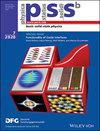后界面钝化 Al2O3 对带有掺氟二氧化锡背触点的双面沸石基太阳能电池性能的影响
IF 1.8
4区 物理与天体物理
Q3 PHYSICS, CONDENSED MATTER
引用次数: 0
摘要
本文研究了超薄 Al2O3 作为 F:SnO2 (FTO) 背接触的克斯特石太阳能电池的后界面钝化层,以提高其潜在性能。在钝化层上,沉积了一层薄薄的钼,以改善 FTO 的电阻率。此外,还在铜锌锡硫化物(CZTS)前驱体上蒸发 NaF,以便在钝化层上形成开口,从而在吸收器中实现由 Na 引发的优势。直接沉积在涂有 Al2O3 的 FTO 上的 CZTS 吸收体会剥落,而夹层有 Mo 的吸收体则不会剥落。对于纯硫化物钾长石器件,Al2O3 层会降低短路电流密度(JSC),从而导致器件效率低下。另一方面,带有 Al2O3 钝化层的硫化物和硒化物混合钾长石器件的短路电流密度明显提高,电流密度-电压曲线表明后界面的势垒高度降低。因此,效率从不带 Al2O3 的器件的 1.5% 提高到带 Al2O3 的器件的 4.6%。同样,在有钝化层的器件中,背面和正面照明的外部量子效率响应也有所改善。因此,从本研究的结果来看,Al2O3 钝化层对基于钾长石的太阳能电池性能的贡献是显而易见的。本文章由计算机程序翻译,如有差异,请以英文原文为准。
Effects of Al2O3 Rear Interface Passivation on the Performance of Bifacial Kesterite‐Based Solar Cells with Fluorine‐Doped Tin Dioxide Back Contact
Herein, ultrathin Al2 O3 is investigated as a rear interface passivation layer for kesterite solar cells with F:SnO2 (FTO) back contact for potential performance improvement. On the passivation layer, a thin Mo layer is deposited to improve the FTO's ohmicity. Further, NaF is evaporated on the copper zinc tin sulfide (CZTS) precursors to create openings at the passivation layer and achieve Na‐induced benefits in the absorber. The CZTS absorbers deposited directly on the Al2 O3 ‐coated FTO peel off, while those with Mo interlayer do not. For pure sulfide kesterite devices, the Al2 O3 layer reduces the short‐circuit current density (J SC ), resulting in poor device efficiency. On the other hand, significantly higher J SC is realized for mixed sulfide and selenide kesterite devices with Al2 O3 passivation layer, with the current density–voltage curve suggesting a reduced barrier height at the rear interface. As a result, the efficiency is improved from 1.5% for devices without Al2 O3 to 4.6% for those with Al2 O3 . Likewise, improved external quantum efficiency response is observed in the devices with passivation layer for backside and frontside illumination. Therefore, contribution of Al2 O3 passivation layer to the performance of kesterite‐based solar cells is evident from the results of this study.
求助全文
通过发布文献求助,成功后即可免费获取论文全文。
去求助
来源期刊
CiteScore
3.30
自引率
6.20%
发文量
321
审稿时长
2 months
期刊介绍:
physica status solidi is devoted to the thorough peer review and the rapid publication of new and important results in all fields of solid state and materials physics, from basic science to applications and devices. Being among the largest and most important international publications, the pss journals publish review articles, letters and original work as well as special issues and conference contributions.
physica status solidi b – basic solid state physics is devoted to topics such as theoretical and experimental investigations of the atomistic and electronic structure of solids in general, phase transitions, electronic and optical properties of low-dimensional, nano-scale, strongly correlated, or disordered systems, superconductivity, magnetism, ferroelectricity etc.

 求助内容:
求助内容: 应助结果提醒方式:
应助结果提醒方式:


